I write in response to “Numbers tell success story of Indians?” (NST,Dec 10) and no “No truth Indians are the poorest in the country?” (NST,Dec 12).
When studies are presented to the public, they must stand up to scrutiny.
I am not a politician, a mathematician or even a statistician. Maybe other Malaysians are more enlightened and I may be wrong but to me the figures quoted do not tally as the statistical methodology seems to be flawed.
The slant of a study can be used to justify any claim. As a simple example, I can say that one out of 10 Malaysians are killed by an elephant.
All I have to do is to find that one unfortunate Malaysian and I have justified my claim.
The population of Malaysia is about 28 million. We are comparing three populations with a vast difference in numbers-Bumiputera 64 per cent (17,920,000), Chinese 24 per cent (6,720,000), and Indians eight per cent (2,240,000).
By convention, all Malays are Bumiputera but not all Bumiputeras are Malays.
In the Malaysian context, the term Bumiputer embraces ethnics Malays plus other indigenous ethnic groups such as the Orang Asli and tribal people in Sabah and Sarawak.
We all know that the indigenous groups have the lowest income and highest rate of unemployment, and this naturally skews the mean household income to the negative.
To make the mean household income of the three main races more relevant, then, the Malays should not be lumped together with the indigenous groups.
Furthermore, the larger the population and with varying reproductive rates, the more the number of unemployable people, - children, students and housewives.
Naturally, then, on paper, wealth distributed among 17 million will be less than wealth divided among two million.
As far as income and population is concerned, should we be using the mean or median values?
The mean is calculated by adding together all the studied values and then divided by the number of values. The data is value only if it is symmetrically distributed but it can be thrown out by a few extreme values.
Ananda Krishnan of Maxis is the third wealthiest man in southeast Asia with a fortune estimated to be worth RM30 billion and other Indian multi-millionaires do not represent the majority of the Indians population.
If they are part of the data, then the study is already skewed.
The median is the middle value – 50 per cent of values is above it and 50 per cent below it. So in an unsymmetrical data, as above, this form of average gives a better ideas of any general tendency.
Different races also have a tendency to gravitate towards different professions which pay different incomes.
If we want to continue using a mean household income as a yardstick of prosperity for the three main races, then we must compare the total income accrued in the selected professions divided by the same number of households.
At the end of the day, we are distracted by superficialities. Poverty is no respecter of race, religion or locality (i.e urban or rural) and all those suffering need the government’s help.
F.S MALHI, Ipoh.
NEWS STRAITS TIMES
Thursday, December 20, 2007






